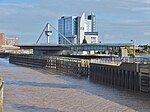Drypool
Geographic coordinate listsGeographic histories of Kingston upon HullLists of coordinatesUse British English from September 2013Wards and districts of Kingston upon Hull

Drypool (archaic Dripole) is an area within the city of Kingston upon Hull, England. Historically Drypool was a village, manor and later parish on the east bank of the River Hull near the confluence of the Humber Estuary and River Hull; it is now part of the greater urban area of Kingston upon Hull, and gives its name to a local government ward. Modern Drypool ward is a mixture of light industrial developments and housing, mainly terraced, as well as the post 1980s housing development 'Victoria Dock Village' built on the infilled site of the former Victoria Dock. The area also includes 'The Deep' aquarium, several schools, and a swimming baths.
Excerpt from the Wikipedia article Drypool (License: CC BY-SA 3.0, Authors, Images).Drypool
Great Union Street, Hull Drypool
Geographical coordinates (GPS) Address Nearby Places Show on map
Geographical coordinates (GPS)
| Latitude | Longitude |
|---|---|
| N 53.74467 ° | E -0.32471 ° |
Address
Great Union Street
Great Union Street
HU9 1UB Hull, Drypool
England, United Kingdom
Open on Google Maps









